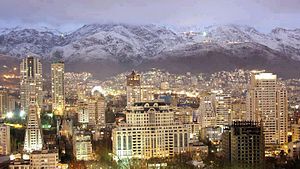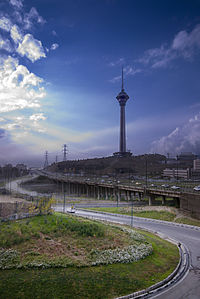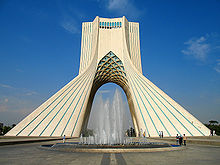Tehran , is the capital of Iran and Tehran Province. With a population of around 8.3 million and surpassing 14 million in the wider metropolitan area, Tehran is Iran's largest city and urban area, and one of the largest cities in Western Asia.

In the 20th and 21st centuries, Tehran has been the subject of mass migration of people from all around Iran.[4] The city is home to many historic mosques, churches, synagogues and Zoroastrian fire temples. However, modern structures, notably Azadi (Freedom) Tower and the Milad Tower, have come to symbolise the city. Tehran is ranked 29th in the world by the population of its metropolitan area.[5] Throughout Iran's history, the capital has been moved many times, and Tehran is the 32nd national capital of Iran although it has been Iran's capital for about 220 years.

Economy
Tehran is the economic centre of Iran. About 30% of Iran's public-sector workforce and 45% of large industrial firms are located Today many modern industries of this city include the manufacturing of automobiles, electronics and electrical equipment, weaponry, textiles, sugar, cement, and chemical products. It is also a leading center for the sale of carpets and furniture. There is an oil refinery near Ray, south of the city.
Tehran relies heavily on private cars, buses, motorcycles, and taxis, and is one of the most car-dependent cities in the world. The Tehran Stock Exchange, which is a full member of the Federation Internationale des Bourses de Valeurs (FIBV) and a founding member of the Federation of Euro-Asian Stock Exchanges, has been one of the world's best performing stock exchanges in recent years.
Azadi Square

Cars
Automotive industry in Iran According to the head of Tehran Municipality's Environment and Sustainable Development Office, Tehran has a capacity for 700,000 cars but currently more than 3 million cars are on the roads in the capital.
Airport
Tehran is served by two main airports. Mehrabad Airport, an old airport , is used for domestic and charter flights. This airport is located in the Western part of the city. Tehran Imam Khomeini International Airport located 50 kilometres (31 miles) south of the city, handles all scheduled international flights.
Tehran Metro
Tehran claims to have one of the cleanest and most convenient metro systems, in terms of accessibility to different parts of the city, in the region. The feasibility study and conceptual planning of the construction were started in 1970s. In 2001, the first two of the eight projected metro lines were opened. Tehran Metro has four operative lines and is 130 km (81 mi) long with another two lines under construction.
Iranian Railways
Tehran also has a central railway station with connecting services round the clock to various cities in the country. A Tehran-Europe train line is also running.
Bus
Tehran's transport system includes conventional buses, trolleybuses and Bus Rapid Transit (BRT). Buses have served the city since the 1920s. There are four bus terminals that also provide connections at low rates The terminals are located on the South, East, West, and Bei-haghi Park-Drive.
Tehran Night


In the 20th and 21st centuries, Tehran has been the subject of mass migration of people from all around Iran.[4] The city is home to many historic mosques, churches, synagogues and Zoroastrian fire temples. However, modern structures, notably Azadi (Freedom) Tower and the Milad Tower, have come to symbolise the city. Tehran is ranked 29th in the world by the population of its metropolitan area.[5] Throughout Iran's history, the capital has been moved many times, and Tehran is the 32nd national capital of Iran although it has been Iran's capital for about 220 years.

Economy
Tehran is the economic centre of Iran. About 30% of Iran's public-sector workforce and 45% of large industrial firms are located Today many modern industries of this city include the manufacturing of automobiles, electronics and electrical equipment, weaponry, textiles, sugar, cement, and chemical products. It is also a leading center for the sale of carpets and furniture. There is an oil refinery near Ray, south of the city.
Tehran relies heavily on private cars, buses, motorcycles, and taxis, and is one of the most car-dependent cities in the world. The Tehran Stock Exchange, which is a full member of the Federation Internationale des Bourses de Valeurs (FIBV) and a founding member of the Federation of Euro-Asian Stock Exchanges, has been one of the world's best performing stock exchanges in recent years.
Azadi Square

Cars
Automotive industry in Iran According to the head of Tehran Municipality's Environment and Sustainable Development Office, Tehran has a capacity for 700,000 cars but currently more than 3 million cars are on the roads in the capital.
Airport
Tehran is served by two main airports. Mehrabad Airport, an old airport , is used for domestic and charter flights. This airport is located in the Western part of the city. Tehran Imam Khomeini International Airport located 50 kilometres (31 miles) south of the city, handles all scheduled international flights.
Tehran Metro
Tehran claims to have one of the cleanest and most convenient metro systems, in terms of accessibility to different parts of the city, in the region. The feasibility study and conceptual planning of the construction were started in 1970s. In 2001, the first two of the eight projected metro lines were opened. Tehran Metro has four operative lines and is 130 km (81 mi) long with another two lines under construction.
Iranian Railways
Tehran also has a central railway station with connecting services round the clock to various cities in the country. A Tehran-Europe train line is also running.
Bus
Tehran's transport system includes conventional buses, trolleybuses and Bus Rapid Transit (BRT). Buses have served the city since the 1920s. There are four bus terminals that also provide connections at low rates The terminals are located on the South, East, West, and Bei-haghi Park-Drive.
Tehran Night
